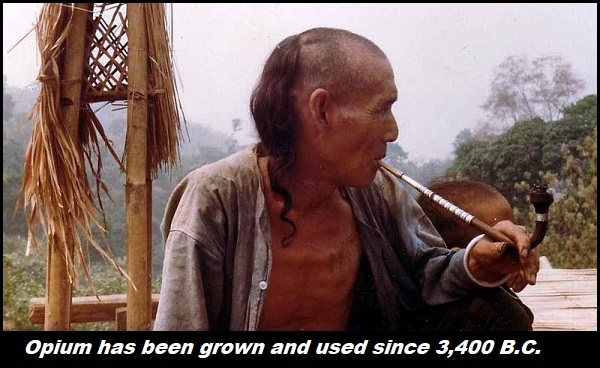For millennia, opioids (natural or synthetic opium-like drugs) have been regarded as the most effective treatment for pain.
The earliest reference to opium growth and use is in 3400 B.C., when the poppy plant was cultivated in lower Mesopotamia. The ancient Sumerians named it “Hul Gil” – the “Joy Plant.”
They then proceeded to pass the plant and its euphoric effects on to the Assyrians. The Assyrians, in turn, passed it on to the ancient Egyptians.
 Opioids for the Masses
Opioids for the Masses
Opium use eventually spread throughout the ancient world to every major civilization in Europe and Asia. It was used to treat pain, internal diseases, and women’s ailments.
In fact, Hippocrates, the “father of medicine,” acknowledged opium’s ability to alleviate pain and stop bleeding. He routinely prescribed drinking the juice of the white poppy mixed with the seed of nettle.
Around 330 B.C., Alexander the Great introduced opium to India. And, before you know it, the Arabs, Greeks and Romans were using it as a sedative. By the third century A.D., Chinese surgeons were orally administering a mixture of opium and cannabis to their patients prior to surgery.
And Then There Was Laudanum
Fast forward to 1527. Swiss-German alchemist, Paracelsus, founder of toxicology, experimented with a specific tincture of opium in an alcohol base that was of considerable use in reducing pain.

He called this preparation “laudanum,” derived from the Latin verb for “to praise.” Other physicians began recommending the drug for practically every ailment — and to soothe fussy babies.
Civil War and “Soldier’s Disease”
In the early 1800’s morphine was isolated from opium, and it became the pain killer of choice throughout the 19the century. With the invention of the hypodermic needle in 1853, morphine began to be used in minor surgical procedures, as well.
As a result, a large number of soldiers became addicted to morphine during the Civil War. Morphine addiction was dubbed “Soldier’s Disease.”
Heroin: The “Safer” Alternative
A safer, less addictive, alternative was sought.

By 1874 the answer was thought to be found in the invention of a new drug in Germany. The new wonder drug was called heroin. It was a synthesized derivative of morphine which was touted as a “safe, non-addictive” substitute by German chemical company Bayer.
 According to a National Institutes of Health report, “In the early 20th century, when heroin was legally marketed in pill form, it was used by young Americans to elicit intense euphoria by crushing the heroin pills into powder for inhalation or injection.”
According to a National Institutes of Health report, “In the early 20th century, when heroin was legally marketed in pill form, it was used by young Americans to elicit intense euphoria by crushing the heroin pills into powder for inhalation or injection.”
In 1909, the first shot in the war on drugs was fired when Congress passed the Opium Exclusion Act. The federal legislation barred all importation of opium for the purposes of smoking. Then, in 1914, the Harrison Narcotics Tax Act was the first attempt at regulating the medical distribution of opiates.
Bayer quickly stopped the mass production of heroin as a result of its hazardous use and dependence. But a safer substitute for morphine was still needed, so in 1916 German scientists at the University of Frankfurt first synthesized oxycodone.
The Heroin Act of 1924 made the importation, manufacture and possession of heroin illegal in the U.S. (including medicinal use). Many members of the medical community at this time believed that opiates were an acceptable substitute for those dealing with alcohol addiction.
New Opioids and the War on Drugs
By 1950 oxycodone had been approved by the FDA and it became widely available as Percodan® (oxycodone and aspirin tablets). Since the early 1960’s the abuse of this drug has been a continuing problem in the U.S. Also in the 1960’s, a resurgence in illegal heroin smuggled into the United States was attributed to the war in Vietnam.

Pressure was mounting for the government to step in. As a result, the Controlled Substances Act was passed in 1970. The act consolidated all of the regulated prescription drugs into five separate schedules, based upon the substance’s medicinal value,  harmfulness and potential for abuse or addiction. Schedule I is reserved for the most dangerous drugs that are no longer allowed to be prescribed, such as heroin.
harmfulness and potential for abuse or addiction. Schedule I is reserved for the most dangerous drugs that are no longer allowed to be prescribed, such as heroin.
A 1973 Executive Order created the Drug Enforcement Agency (DEA). President Richard Nixon officially declared the War on Drugs, noting that “America has the largest number of heroin addicts of any nation in the world. Heroin addiction is….the most socially destructive form of addiction in America today.”
“No Risk of Addiction”
At the same time, American medical professionals still largely believed that there was virtually no risk of addiction with long-term use of opioids, so long as it was treating chronic pain. Some medical students were even taught that “pain soaks up the euphoria,” and therefore patients with serious pain could not become addicted to opioids.
The video clip below illustrates the prevailing mindset at that time:
As a result, new opioid pain killers continued to be developed. Vicodin® (a combination of hydrocodone and acetaminophen) was introduced into the U.S. in 1978 by German pharmaceutical company, Knoll.
 Gerald Ford’s administration pushed the War on Drugs into the background. (Ironically, during this time, First Lady Betty Ford was herself heavily addicted to opioids.)
Gerald Ford’s administration pushed the War on Drugs into the background. (Ironically, during this time, First Lady Betty Ford was herself heavily addicted to opioids.)
But during the 1980’s, President Ronald Reagan and First Lady Nancy Reagan asked Americans to join a national crusade to “Just Say No” to drugs. “Drugs” at that time, however, did not include prescription medications.
By 1984, cocaine had largely outpaced heroin as the recreational drug of choice for 4 to 5 million users. Heroin use was down; prescription opioid use was up.
During the 1990’s clinicians and pain societies successfully lobbied for increased use of opioids for all pain types. Prescription opioids were reformulated for extended time release. One such drug, Oxycontin, has now become the most dangerous narcotic in history.
By 1999, an estimated 4 million people, about 2% of the population age 12 and older, were using prescription drugs non-medically.
They Were Wrong
That number continued to grow exponentially.
 Between 1998 and 2008, the abuse of opioid products doubled. In 2009, the number of emergency room visits attributed to abuse of prescription painkillers had increased to more than 730,000 – nearly double that of 2004.
Between 1998 and 2008, the abuse of opioid products doubled. In 2009, the number of emergency room visits attributed to abuse of prescription painkillers had increased to more than 730,000 – nearly double that of 2004.
By 2010, enough prescription opioids were being sold to medicate every adult in the United States with a dose of five milligrams of Hydrocodone every four hours for a month.
By the time medical professionals realized the addictive nature of all opioids, it was already too late.
Opioid abuse had reached epidemic proportions. By 2015, it had become America’s deadliest drug crisis ever.
The following Fox News video highlights the scope of the current problem:
Sources:

